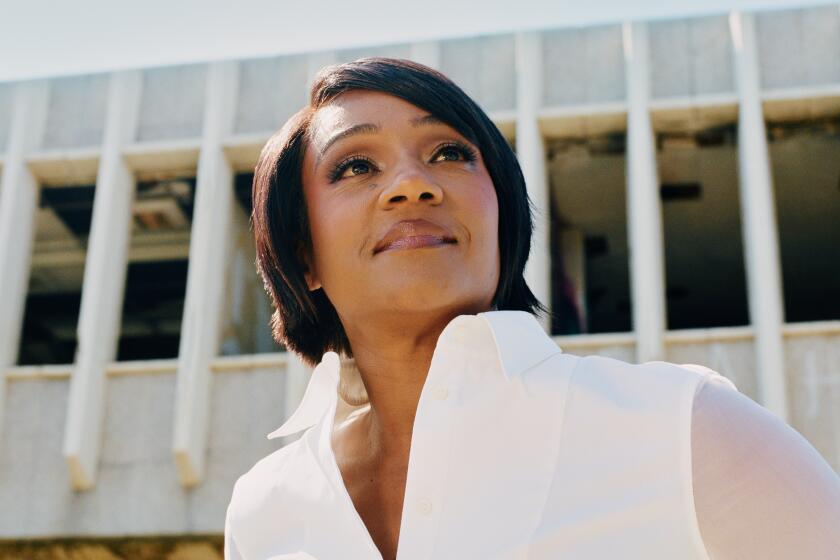Study finds ‘inclusion crisis’ at Hollywood studios
A sweeping new report on the lack of diversity in Hollywood has turned up the heat on the major film and TV studios, providing further ammunition for critics who say the industry does not reflect America’s demographics.
The study released Monday by the USC Annenberg School for Communication and Journalism takes the country’s biggest media conglomerates to task, likening the film studios to a “straight, white, boys’ club.”
USC researchers concluded that women, ethnic minorities, and gay, lesbian and transgendered people were excluded at all levels of the industry, thereby creating an “epidemic of invisibility.”
The study represents one of the broadest examinations to date on an issue that has roiled Hollywood. USC researchers examined 414 feature films and TV shows from major studios — such as Walt Disney Co. and 20th Century Fox — and analyzed the prevalence of women and minorities in front of and behind the camera.
Only 29% of all film speaking roles were filled by women, the report found, and just 28% of all speaking characters were non-white, compared with 38% of the U.S. population. Only 2% of roles were identified as gay, lesbian or bisexual.
The study revealed an even larger disparity behind the camera: Nearly 85% of directors and 71% of screenwriters were male.
“We don’t have a diversity problem, we have an inclusion crisis,” said researcher Stacy Smith at the USC Annenberg School for Communication and Journalism, who was one of the study’s authors. “We’re really talking about a lack of inclusivity across the landscape. There are people that are just missing from storytelling, and that’s not consistent with the demography of the United States.”
The report comes less than a week before ABC’s Sunday broadcast of the Oscars, which has come under fire for nominating an all-white group of actors for the second straight year. Following the outcry over the nominations, the Academy of Motion Picture Arts and Sciences announced major changes to its rules for voting members to freshen its heavily white and male-skewing roster. The Equal Employment Opportunity Commission has also been investigating alleged gender discrimination in Hollywood.
Amid the uproar, studios and TV networks have faced mounting pressure to deal with the lack of diversity in the entertainment industry. Some activists, such as director Spike Lee, have said the problem stems from the executive ranks of the studios, which are largely white and male.
The findings echo research from other reports, including surveys by UCLA’s Ralph J. Bunche Center for African American Studies.
“This is pretty much what we’ve seen all along,” said Darnell Hunt, director of the center. “It’s the age-old problem. It’s the structure of the industry and the way people make decisions about what gets made. There’s not enough diversity in the room.”
Disney, Warner Bros. and Sony Pictures declined to comment. Fox, Universal Pictures and Paramount Pictures did not respond to requests for interviews.
The USC study presented an unflattering view of the major media companies, scoring each based on the diversity of the lead and speaking characters in their shows and movies, along with the number of women writers and directors working behind the scenes. It analyzed 109 theatrical movies released in 2014, and 305 series aired on broadcast and cable channels and on streaming services from Sept. 1, 2014, to Aug. 31, 2015.
The studios’ theatrical films fared especially poorly. The study said Sony, Disney and Warner Bros. used no female directors for their 2014 films. At Fox, 4% of films were directed by women, compared with 9% at Universal and Paramount.
Studio movies featured relatively few minorities in front of the camera, according to the report. Researchers calculated the percentage of speaking roles that went to non-white actors (lead and speaking characters) for each film studio, relative to the percentage of minorities in the U.S. population. Based on that measure, they found that three of the six largest film distributors were “barely inclusive” while one, Time Warner, was “not inclusive.”
Sony and Paramount, however, got high marks for the relatively high number of roles for non-white actors. Sony’s slate benefited from ensemble comedies like “About Last Night” and “Think Like a Man Too,” while Paramount had the civil rights drama “Selma” and the Chris Rock picture “Top Five.” Warner Bros., owned by Time Warner Inc., scored lowest among the major film companies.
Researchers partly blamed the diversity problem on an absence of women and minorities in top jobs at the large media firms. Although a large number of women work in senior vice president positions, their ranks are much thinner at the top of the corporate ladder. Women make up just 21% of top executive positions and 19% of board seats.
“The further you go up, you find there are fewer women,” said USC researcher Marc Choueiti, coauthor of the report.
USC’s study pointed out some positive signs in the entertainment business. The media companies generally scored higher marks for their television shows, which the report portrayed as being significantly more diverse than films.
The CW, Disney, Viacom and the streaming services Amazon and Hulu each received high scores for their inclusion of female TV characters. For minorities, five of 10 major media companies were considered “largely inclusive” or better, according to the study. Disney — which runs ABC, Freeform and Disney Channel — and the CW ranked highest for inclusion in television.
TV has been held up as a model for studios looking to better reflect the audience at large. But despite some bright spots in TV, including ABC’s “Black-ish” and “Fresh Off the Boat,” diversity remains a problem across the TV landscape, the report said.
Only 19% of the shows on the broadcast networks depicted an “ethnic balance,” meaning their casts reflected the diversity of the country. Cable had 13%. Meanwhile, only 7% of films reflected an ethnic balance, and streaming was just 2%.
ryan.faughnder@latimes.com
ALSO:
Lessons from #OscarsSoWhite, from the ABFF Awards red carpet
In her series ‘Make ‘Em All Mexican,’ artist Linda Vallejo imagines #OscarsSoBrown
More to Read
The complete guide to home viewing
Get Screen Gab for everything about the TV shows and streaming movies everyone’s talking about.
You may occasionally receive promotional content from the Los Angeles Times.







